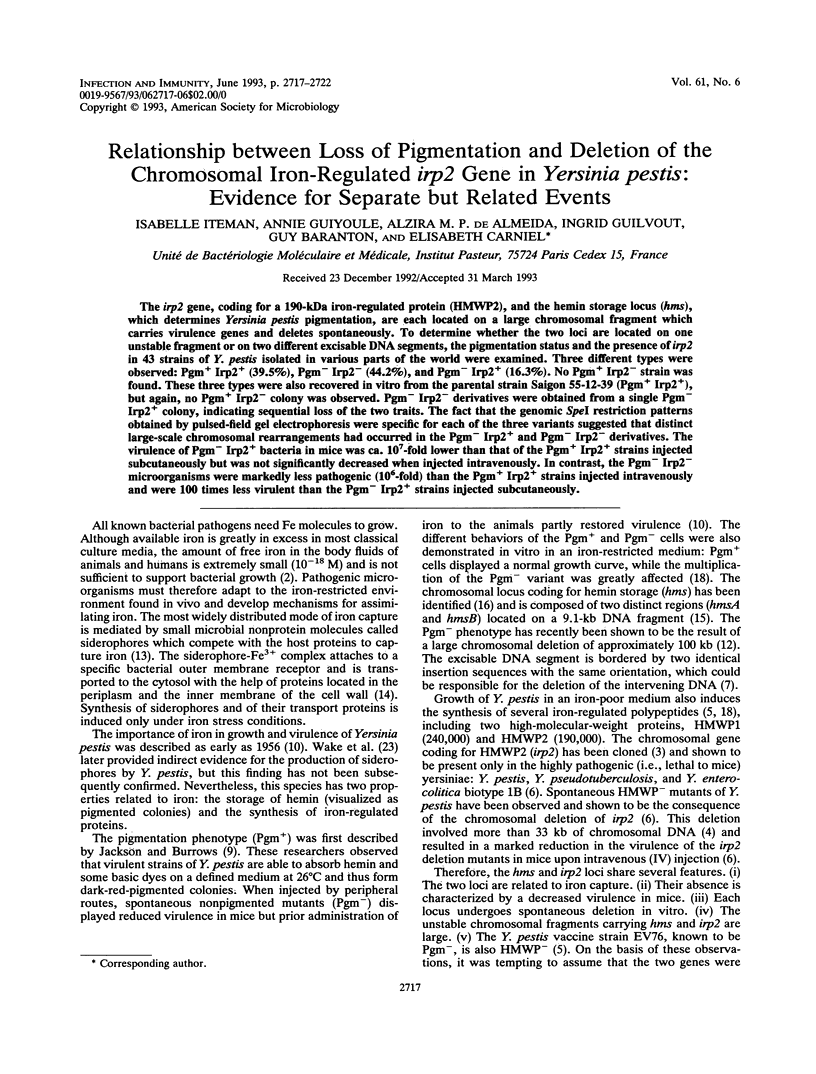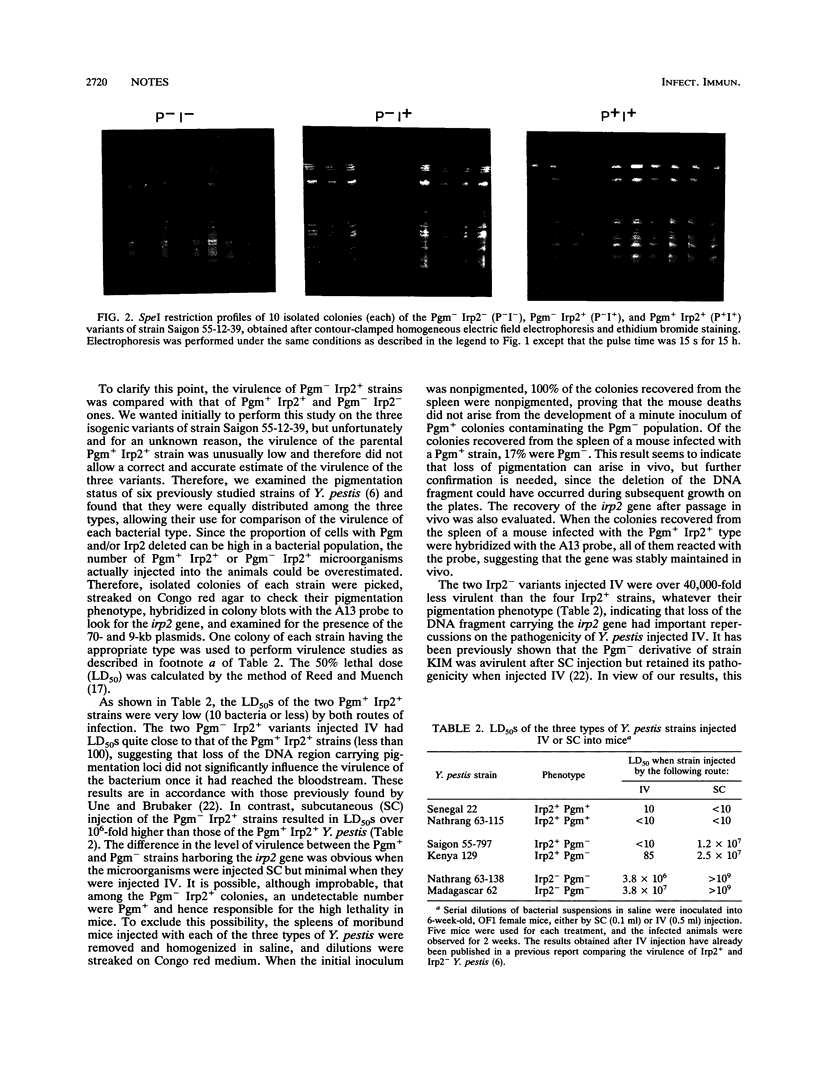Abstract
The irp2 gene, coding for a 190-kDa iron-regulated protein (HMWP2), and the hemin storage locus (hms), which determines Yersinia pestis pigmentation, are each located on a large chromosomal fragment which carries virulence genes and deletes spontaneously. To determine whether the two loci are located on one unstable fragment or on two different excisable DNA segments, the pigmentation status and the presence of irp2 in 43 strains of Y. pestis isolated in various parts of the world were examined. Three different types were observed: Pgm+ Irp2+ (39.5%), Pgm- Irp2- (44.2%), and Pgm- Irp2+ (16.3%). No Pgm+ Irp2- strain was found. These three types were also recovered in vitro from the parental strain Saigon 55-12-39 (Pgm+ Irp2+), but again, no Pgm+ Irp2- colony was observed. Pgm- Irp2- derivatives were obtained from a single Pgm- Irp2+ colony, indicating sequential loss of the two traits. The fact that the genomic SpeI restriction patterns obtained by pulsed-field gel electrophoresis were specific for each of the three variants suggested that distinct large-scale chromosomal rearrangements had occurred in the Pgm- Irp2+ and Pgm- Irp2- derivatives. The virulence of Pgm- Irp2+ bacteria in mice was ca. 10(7)-fold lower than that of the Pgm+ Irp2+ strains injected subcutaneously but was not significantly decreased when injected intravenously. In contrast, the Pgm- Irp2- microorganisms were markedly less pathogenic (10(6)-fold) than the Pgm+ Irp2+ strains injected intravenously and were 100 times less virulent than the Pgm- Irp2+ strains injected subcutaneously.
Full text
PDF





Images in this article
Selected References
These references are in PubMed. This may not be the complete list of references from this article.
- BURROWS T. W., JACKSON S. The pigmentation of Pasteurella pestis on a defined medium containing haemin. Br J Exp Pathol. 1956 Dec;37(6):570–576. [PMC free article] [PubMed] [Google Scholar]
- BURROWS T. W., JACKSON S. The virulence-enhancing effect of iron on nonpigmented mutants of virulent strains of Pasteurella pestis. Br J Exp Pathol. 1956 Dec;37(6):577–583. [PMC free article] [PubMed] [Google Scholar]
- Birch A., Häusler A., Vögtli M., Krek W., Hütter R. Extremely large chromosomal deletions are intimately involved in genetic instability and genomic rearrangements in Streptomyces glaucescens. Mol Gen Genet. 1989 Jun;217(2-3):447–458. doi: 10.1007/BF02464916. [DOI] [PubMed] [Google Scholar]
- Bullen J. J., Rogers H. J., Griffiths E. Role of iron in bacterial infection. Curr Top Microbiol Immunol. 1978;80:1–35. doi: 10.1007/978-3-642-66956-9_1. [DOI] [PubMed] [Google Scholar]
- Carniel E., Guiyoule A., Guilvout I., Mercereau-Puijalon O. Molecular cloning, iron-regulation and mutagenesis of the irp2 gene encoding HMWP2, a protein specific for the highly pathogenic Yersinia. Mol Microbiol. 1992 Feb;6(3):379–388. doi: 10.1111/j.1365-2958.1992.tb01481.x. [DOI] [PubMed] [Google Scholar]
- Carniel E., Guiyoule A., Mercereau-Puijalon O., Mollaret H. H. Chromosomal marker for the 'high pathogenicity' phenotype in Yersinia. Contrib Microbiol Immunol. 1991;12:192–197. [PubMed] [Google Scholar]
- Carniel E., Mazigh D., Mollaret H. H. Expression of iron-regulated proteins in Yersinia species and their relation to virulence. Infect Immun. 1987 Jan;55(1):277–280. doi: 10.1128/iai.55.1.277-280.1987. [DOI] [PMC free article] [PubMed] [Google Scholar]
- Fetherston J. D., Schuetze P., Perry R. D. Loss of the pigmentation phenotype in Yersinia pestis is due to the spontaneous deletion of 102 kb of chromosomal DNA which is flanked by a repetitive element. Mol Microbiol. 1992 Sep;6(18):2693–2704. doi: 10.1111/j.1365-2958.1992.tb01446.x. [DOI] [PubMed] [Google Scholar]
- Iteman I., Baril C., Saint Girons I., Carniel E. Pulse field electrophoresis of the chromosome of the pathogenic yersiniae. Contrib Microbiol Immunol. 1991;12:198–202. [PubMed] [Google Scholar]
- Knapp S., Hacker J., Jarchau T., Goebel W. Large, unstable inserts in the chromosome affect virulence properties of uropathogenic Escherichia coli O6 strain 536. J Bacteriol. 1986 Oct;168(1):22–30. doi: 10.1128/jb.168.1.22-30.1986. [DOI] [PMC free article] [PubMed] [Google Scholar]
- Lucier T. S., Brubaker R. R. Determination of genome size, macrorestriction pattern polymorphism, and nonpigmentation-specific deletion in Yersinia pestis by pulsed-field gel electrophoresis. J Bacteriol. 1992 Apr;174(7):2078–2086. doi: 10.1128/jb.174.7.2078-2086.1992. [DOI] [PMC free article] [PubMed] [Google Scholar]
- Neilands J. B. Microbial envelope proteins related to iron. Annu Rev Microbiol. 1982;36:285–309. doi: 10.1146/annurev.mi.36.100182.001441. [DOI] [PubMed] [Google Scholar]
- Neilands J. B. Microbial iron compounds. Annu Rev Biochem. 1981;50:715–731. doi: 10.1146/annurev.bi.50.070181.003435. [DOI] [PubMed] [Google Scholar]
- Pendrak M. L., Perry R. D. Characterization of a hemin-storage locus of Yersinia pestis. Biol Met. 1991;4(1):41–47. doi: 10.1007/BF01135556. [DOI] [PubMed] [Google Scholar]
- Perry R. D., Pendrak M. L., Schuetze P. Identification and cloning of a hemin storage locus involved in the pigmentation phenotype of Yersinia pestis. J Bacteriol. 1990 Oct;172(10):5929–5937. doi: 10.1128/jb.172.10.5929-5937.1990. [DOI] [PMC free article] [PubMed] [Google Scholar]
- Sikkema D. J., Brubaker R. R. Outer membrane peptides of Yersinia pestis mediating siderophore-independent assimilation of iron. Biol Met. 1989;2(3):174–184. doi: 10.1007/BF01142557. [DOI] [PubMed] [Google Scholar]
- Stragier P., Kunkel B., Kroos L., Losick R. Chromosomal rearrangement generating a composite gene for a developmental transcription factor. Science. 1989 Jan 27;243(4890):507–512. doi: 10.1126/science.2536191. [DOI] [PubMed] [Google Scholar]
- Surgalla M. J., Beesley E. D. Congo red-agar plating medium for detecting pigmentation in Pasteurella pestis. Appl Microbiol. 1969 Nov;18(5):834–837. doi: 10.1128/am.18.5.834-837.1969. [DOI] [PMC free article] [PubMed] [Google Scholar]
- Une T., Brubaker R. R. In vivo comparison of avirulent Vwa- and Pgm- or Pstr phenotypes of yersiniae. Infect Immun. 1984 Mar;43(3):895–900. doi: 10.1128/iai.43.3.895-900.1984. [DOI] [PMC free article] [PubMed] [Google Scholar]
- Wake A., Misawa M., Matsui A. Siderochrome production by Yersinia pestis and its relation to virulence. Infect Immun. 1975 Nov;12(5):1211–1213. doi: 10.1128/iai.12.5.1211-1213.1975. [DOI] [PMC free article] [PubMed] [Google Scholar]




